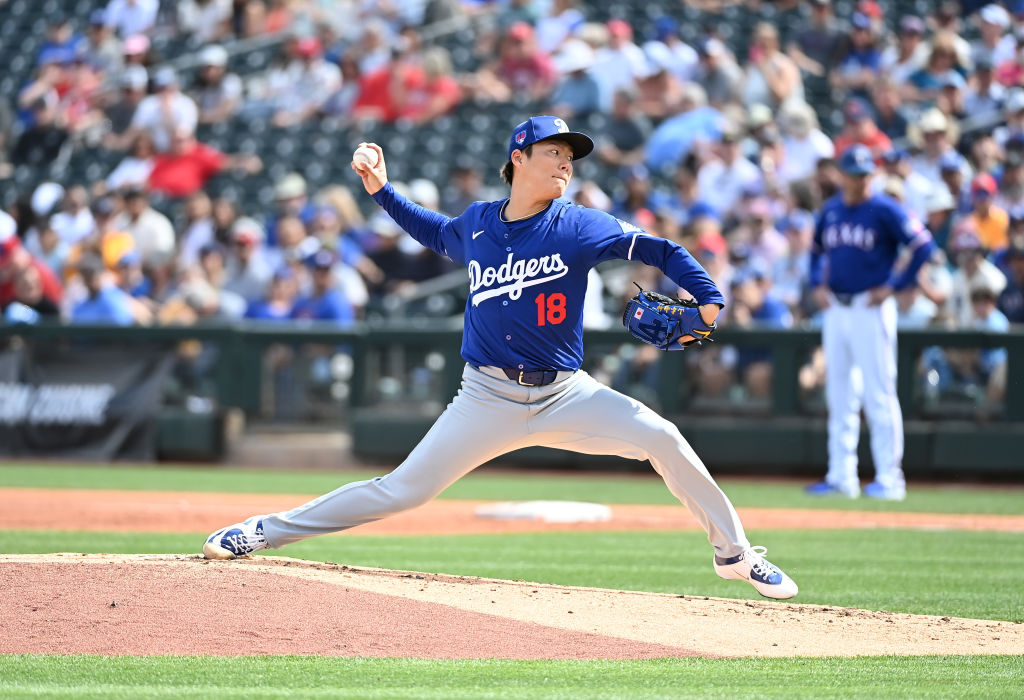


Yoshinobu Yamamoto of the Los Angeles Dodgers delivers a spitch against the Texas Rangers during a spring training game at Surprise Stadium on February 28, 2024 in Surprise, Arizona. (Photo by Norm Hall/Getty Images)
By Leif Skodnick
World Baseball Network
Don’t tell the Los Angeles Dodgers or their fans that spring training games don’t count.
On Wednesday, during the spring training game between the Texas Rangers, who won the World Series, and the Los Angeles Dodgers, who committed over $1 billion in salary to two pitchers with the goal of knocking the Rangers off the top of the hill, Yoshinobu Yamamoto made his first spring training appearance.
Yamamoto has won three consecutive MVP awards in Nippon Professional Baseball, three consecutive Eiji Sawamura Awards – the NPB’s equivalent of the Cy Young Award – and contributed to championships in the 2020 Olympic Games with Japan, the 2022 Japan Series with the Orix Buffaloes, and the 2023 World Baseball Classic, again with Japan.
The list of accomplishments the 25-year-old has put together are remarkable, and have only contributed to the hype that has followed him across the Pacfic.
“This is the beginning, this is the launching of another career. His career was hall-of-fame type in his native Japan,” SNLA color commentator and former Dodgers outfielder Rick Monday said before Yamamoto had taken the mound Tuesday, stating the obvious in a way that broadcasters too often do. “And now he opens the book here, this afternoon, on his legacy in the Dodger uniform.”
By signing Shohei Ohtani for $700 million over the next 10 years, the Los Angeles Dodgers invested in a two-time MVP who will, they hope, maintain his power at the plate while rehabbing from ulnar collateral ligament surgery and return to pitching form as the greatest two-way threat Major League Baseball has seen since Babe Ruth.
By signing Yamamoto for $325 million over the next 12 years, the Dodgers bought a lottery ticket.
Quality starting pitching is possibly the scarcest commodity in sports. There just aren’t enough human beings who can hurl a five-ounce, nine-inch baseball and make it dance in the air well enough to fool Major League hitters.
Is Yamamoto one of those guys?
Based upon his performance in Japan, he certainly could be.
But to look back at the list of pitchers who have come over from Japan since Hideo Nomo joined the Dodgers in 1994 is to look at a list of high-priced pitchers who, for the most part, never lived up to the hype.
Nomo, who won the 1995 National League Rookie of the Year with the Dodgers, was largely a journeyman after that magical first season when his unique motion captured the attention of American fans. After posting an ERA+ of 149 in 1995, Nomo posted just two more seasons where his ERA+, a statistic that normalizes a pitcher’s ERA to a Major League average of 100, was above 100.
Daisuke Matsuzaka, for whom the Boston Red Sox paid $51,111,111.11 to the Seibu Lions merely for the right to attempt to negotiate a contract, had two great seasons at Fenway Park before being a relatively pedestrian Major League starter for the rest of his time pitching with the Red Sox and the New York Mets.
Masahiro Tanaka, to whom the Yankees handed $155 million over seven years, showed flashes of brilliance, but only when he had plenty of rest. He posted a career ERA+ of 114 over his seven seasons in New York, along with a 78-46 record and 3.74 ERA.
Yu Darvish and Ohtani came over from Japan and have experienced long-term success in the Major Leagues, but then there are guys like Kei Igawa, who finished out his time with the New York Yankees organization pitching for Double-A Trenton, three years removed from his 16th and final MLB appearance. With pitching, caveat emptor seemingly always applies.
Two-inning outings by starters early in spring training are seldom about the results and more about getting in the routine of making a start, but the results were there for Yamamoto on Tuesday.
He struck out his first batter, Marcus Semien, by blowing a 2-2 fastball past him. After Evan Carter made good contact with a fastball, roping a single to center, Yamamoto stayed calm and got Wyatt Lankford, the fourth overall selection in last year’s draft, to ground into a 5-4-3 double play to end the bottom of the first.
And he looked just as good in the second inning, fanning Nathaniel Lowe, getting Jonah Heim to fly out to left, and then sent Leody Taveras down swinging.
Two innings doesn’t make a season, much less a career, and Yamamoto and the Dodgers have merely taken the first steps on their 12-year journey.
But under the heaviest of expectations in an otherwise meaningless game, Yamamoto’s performance lived up to the hype.
For those who keep track of such things, the Rangers won the game, 6-4.